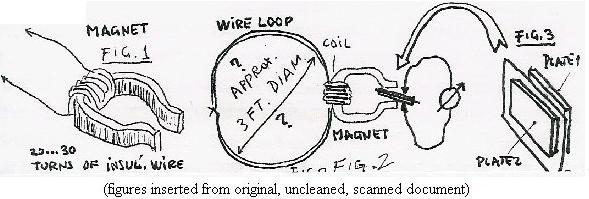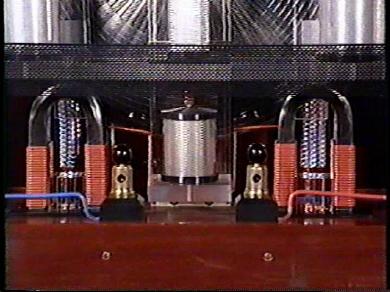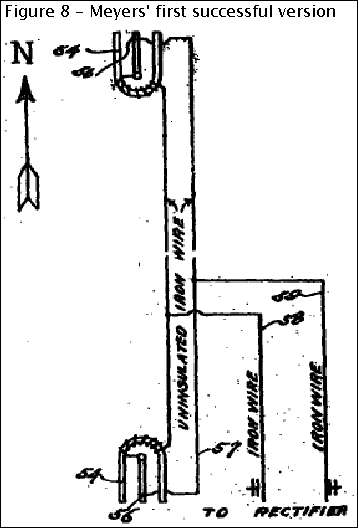The Linden experiment was performed by Paul Baumann for two visitors. They then described it to someone who wrote it in a letter. The following is the text from that letter that describes the experiment. The information is therefore second hand and taken from memory. As such the details may not be exact. The diagrams below the text were on the same page of the letter that the text was on. The names have been replaced with "____" at the request of the letter writer. Paul Baumann's followers call him "Vatti" (daddy).
|
The two engineers asked Vatti how the machine was working, and he started to explain the "principle." He said that in Nature, there are very fine particles and all going at random (fluctuation) and at an incredible speed. To control and have an advantage of this fact, one must find a means to "rectify" the flux.... He took a U-shaped magnet from the drawer and asked ____ to wind a normal installation wire on to the middle of the U-shape (Fig.1). The ends of the wire were kept at a certain length (____ said, maybe 3 feet each.) The very ends were stripped off the insulation and galvanicly connected, thus forming a loop. This was placed on the table (what was underneath?) (Fig.2). Paul Baumann took two small metal plates and put them together with some paper in between (Fig.3) This was like a flat capacitor. Now he placed this "sandwich," holding it with his fingers in the "jaw" of the Magnet, i.e. between the poles. After a short trial to find the best position, he asked the engineer to put the probes of his voltmeter onto the plates. ____'s surprise: there was a voltage of 700 volts indicated! P.B. said, "When you understand this, you know how it works. This is just the beginning." Back in their own laboratory, ____ tried to repeat the experiment. I also tried to get such an output. No result! I have asked ____ whether he had his meter in position "Resistance" and he had measured Vatti's skin resistance. He says that he was definitely sure what he was doing. He added to this, "The relative high voltage seemed to drop slowly when I had the instrument on the plates." (This would correspond to the normal experience when an Owm-meter's probes are touched with both hands (progressive polarization of the skin surface due to the applied voltage/current).
|
Replication attempts
- Testatika Magnet Experiments - Series 1
- Testatika Magnet Experiments - Series 2
- Testatika Magnet Experiments - Series 3 (including converting HV spikes to low voltage DC)
Linden Experiment Magnet
The type of magnet used in the Linden experiment was like a meter magnet and as such, anyone trying to replicate it should try with one like it. Note also that since a meter magnet may have been used, physical contact between the plates and the magnet itself may be necessary.
|
|
|
I found my meter magnet by purchasing an old meter on ebay. It's important that it be old, possibly made before 1980. Meters nowadays seem to all use a pair of small neodimium magnets and my understanding is that neodimium magnets didn't exist before the 1980s. Also, one of the meters I purchased on ebay had a range of 0 to 100 amps and did not have the desired type of magnet, possibly because the current from the source was so large that such a magnet was not needed. The meter that I found that contained the desired magnet offered a milliampere range. The ebay seller also pointed out that the meter case was made of bakelite, a type of plastic use in the first half of the 20th century, further guaranteeing its age.
Testing for resistance with a digital multimeter I found that the entire magnet was made of an electrically conductive material, the resistance from any point on the surface to any other being around 0.2ohms. Also, the external magnetic field was fairly weak everywhere except in the area of the gap, where it was very strong.
|
|
| ||
|
|
|
Shape of magnetic field between legs of U-shaped/horseshoe magnet
I'd always thought that the magnetic field lines between the legs of a U-shaped/horseshoe magnet run parallel to the legs. Back in 2000, I tested this by placing a U-shaped magnet under a sheet of plexiglass and placing iron filings on the plexiglass.
The following resulting photos show that the field lines on the insides of the legs go directly from one leg to the other leg. This is good since it matches what would be the case with the above meter magnet. It also jibes with the plates in between the legs of the magnets in the 3kW machine being oriented parallel to the legs matching what is shown in the Linden experiment above.
|
|
|
|
Linden Experiment and the Roy Meyers device
Note the similarity between the Linden experiment and the Roy Meyers device. Might the Methernithans have studied, replicated and improved on the Roy Meyers device?
|




